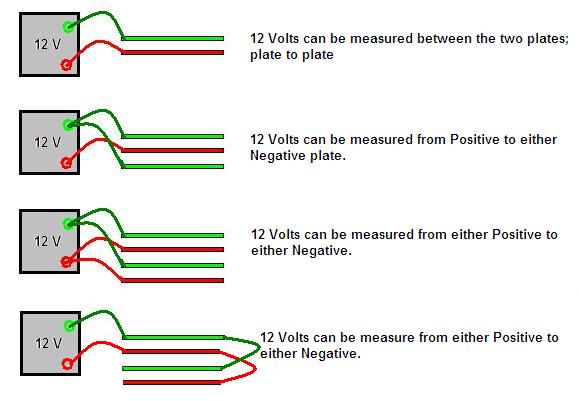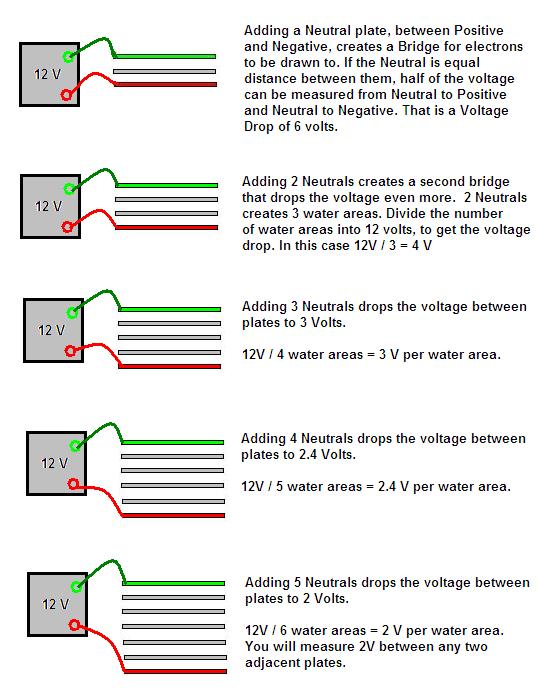I would really
like to know your thoughts/ experience about the difference
between the configuration +NN-NN+ & +-+-+-+- ? The latter seems to
generate more HHO liters per minute but draws more amps, is that
right or what's the story?
Parallel Plates (Unipolar)
Alternating + - + - creates a parallel circuit. Each
plate is wired to the 12 volt battery, or an extended 12 volt
connection. The
batteries 12 volts can be measured between any two plates that are
facing each other. In other words, 12 volts is dropped across each
set of plates. The following examples are parallel plate arrangements;
every plate is either positive of negative:

When electrical current (amps) passes between parallel plates, it
divides if there are more than one set. For example,
If two sets of + - plates are wired to the battery, the electrons
have two paths to take; If the plates are all the same size, and
spaced the same distance apart, the amperage would be divided
equally by 2; half would travel through one set, and half through
the other. So in this example, if 10 amps is being drawn from the
battery, 5 amps could be measured passing through each set of
plates. I hope you are with me so far because it gets a little more
complicated when both sets of plates are equally spaced from each
other.

Close observation of + - + - shows three water areas +
space - space + space - . I represented "space" as the water areas.
If 10 amps of current is being drawn, it would be traveling in 3
paths, thus divided 3 times. So, each set of plates has only 3.333 amps passing through
it.
Adding Neutral Plates (Bipolar)
When Neutrals are introduced + space N space - The same
amount of current travels through each water area. Voltage is
applied to only the end plates, positive and negative. The neutral
plates actually cause a voltage drop. Each
neutral cuts the applied voltage in half. It does this because it
changes the resistance, and spacing between positive and negative;
which in turn changes the electrical pressure between neutral and
positive and neutral and negative. If you measure voltage from the
positive plate to the negative plate, the reading will be 12 volts
of electrical pressure. But if you measure from the neutral plate to
either positive or negative, the reading will be 6 volts of
electrical pressure. So neutral plates are an effective way of
lowering the plate voltage.
In a 12 volt system, using
this configuration of one neutral, the voltage drop between two
adjacent plates would be 6 volts. You have 2 water areas, 12 volts
divided by 2 equals 6 volts. Don't take my word for it, go measure
it. It will be there. The following examples should help:

In effect, Neutrals drop the voltage to the plates. Lower voltage
means less heat. Ideally 1.25 volts is capable of making the most
HHO with the least amount of excess heat. Each Neutral plate has a
positive side and a negative, or should I say a more positive side
and a more negative side. That is why you can measure a voltage drop
between them.
Electrical current, takes the same path as Parallel plates, but it
must also pass through the neutrals. Here is an example comparing
neutral and parallel:

Using Neutrals creates a Series circuit. +space n space n space -
The following would be a Series Parallel circuit: -NN+NN-
We have 12 volts Negative applied to two plates, and one Positive
applied between them, That is a parallel arrangement. Amperage has
to paths to take. However there are Neutrals in
series between each positive and negative. Thus series parallel.

What does all of this mean! It is all brute force electrolysis. But
neutrals allow you to lower the operating voltage to each plate, for
better efficiency, yet have the
same amount of current passing through each plate. The neutrals can
provide additional surface area for HHO production as well as lower
the heat.
Dry Cell
There is a trick to
making the plates more efficient. You must keep the water from leaking around
the edges of the plates. You have to seal the bottom, the sides, and
the tops so that
current can not find its way through the water, around or under the plates.
If it does, the electron flow can bypass the plate surface by
jumping across the water anywhere there are sharp or protruding
edges. That is
Yule Browns theory, which is also suggested by Bob Boyce.
Amperage and Ohms Law
Current flow, in an electrical circuit, is Directly proportional to
the applied voltage and Inversely proportional to the circuit
resistance. That means, If
voltage increases, current flow will increase; as long as Resistance
remains the same. If Voltage decreases, current flow will decrease;
as long as resistance remains the same. In our cell technology, the water is our resistance
and it changes with plate spacing. It directly
determines how many amps of current our cell will draw. The closer
our plates are, the less water there is between them; the lower our
resistance will be. The hotter our water is, the less resistance
there will be. The more electrolytes we add, the less resistance
there will be. Neutral plates cause more resistance ..... because
there is more water between the positive and negative plates, thus we end up
adding more quantities of electrolyte in order to get the water to
pass electron flow from plate to plate. The type of metals we use
for plates also affects resistance, but I will not go there right
now.
Parallel (Unipolar) vs. Series
(Bipolar)
Both use brute force electrolysis. Both can be configured to produce
large or small quantities of HHO. Both can be configured to reduce
heat. Both can be configured efficiently. Stan Meyer used high
voltage and low current, produced by special electronics, along with
Tubes for plates, configured in a parallel arrangement. He believed
that tubes produce 2.75 times more HHO than flat plates. Bob Boyce
uses Series configurations. He uses large numbers of neutral plates
to reduce high voltage to 3 volts per water area between plates, to
produce large quantities of HHO, without special electronics.
The verdict; which is better
It all boils down to the power source. What do you have? How can you
best use it? How much room do you have for a Cell (Hydrogen Oxygen
Generator)? Do you make short commutes, long trips, or both? In most
cases, the Series and Series Parallel Dry Cells are used the most in
automobiles. The reason.... a low voltage 13.5 Alternator powers the
electronics. If you have the knowledge, and the finances, to use
high voltage DC to AC Inverters.... and you have the room to
accommodate the hardware....and the electronics....you can...I say
can....build a system large enough to ...Run your vehicle on Water.
Stan Meyer did it; Bob Boyce says he did it and the men in Black
made him stop; and Fast Freddy; Frederic Woods, well he is not
nicknamed Fast for nothing.
|